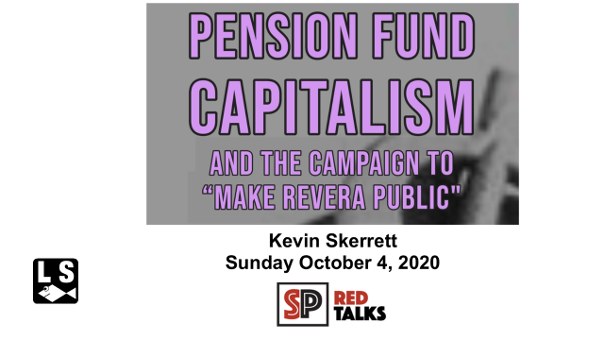Washing our Hands of Financialized Pensions
Rethinking Retirement After COVID-19
The unemployment crisis brought on by the coronavirus outbreak has suddenly destroyed the earnings of hundreds of thousands of working people in Canada. For many jobless workers, the immediate scramble to make ends meet will be followed by a struggle to avoid downward mobility and poverty in the months ahead. But the crisis is also clouding the already uncertain retirement prospects for working people. Having experienced the second market meltdown in a dozen years, accompanied by a further collapse in interest rates, many workers confront growing financial insecurity and thwarted hopes of retiring.

Thus far, unions have responded to this crisis with appeals to government regulators for relief for pension plans. They are right to do so. An immediate objective must be to stabilize these plans and prevent benefit cuts for workers and pensioners.
But on its own, this purely defensive posture is doomed to failure. The outcome of the previous crisis, which also devastated retirement savings, explains why. Following the 2007-08 collapse, pension plans remained under unrelenting pressure from employers and governments determined to offload pension risk and to cut benefits. Uneven investment returns, weak economic growth, and low interest rates, occasioned by the same massive monetary stimulus we are seeing now, fueled these attacks. Unions spent a decade desperately trying to resist concessions and hold on to what they had.
Retirement Income for All
This struggle was mostly unsuccessful. Over the ensuing ten years, the number of private-sector workers with access to a defined benefit (DB) plan fell consistently, to the point where fewer than one in ten today belong to such plans. Furthermore, just over one in five private sector workers has access to any kind of pension plan. Even in the heavily unionized public sector, where 85 per cent of workers have a pension, employers have ceaselessly demanded that workers pay more for diminished pensions, and assume more and more risk.
To make matters worse, as pensions vanish from the private sector, the political right is able to mobilize widespread insecurity and resentment to attack remaining public-sector pensions. Without a definitive break from their purely defensive approach, the future awaiting unions and workers with pensions is clear: another round of demands for benefit cuts, contribution hikes, and more risk and cost heaped on plan members.
While unions must continue to resist these attacks, labour cannot escape the struggle for retirement income for everyone if it wants to preserve any hope of a secure and adequate retirement income for union members. Without a broader program demanding retirement security for all, calls for emergency measures to shore up pensions remain at best irrelevant to a majority of workers, and at worst, a sectionalist appeal that urges lifeboats for a few, while the many sink to their fate.
Building a Class-Wide Fight
The financial crisis already triggered by the COVID-19 pandemic has hit asset-dependent pension funds and individual retirement savings schemes very hard. The largest North American stock market indexes fell by more than 20 per cent in the first quarter of 2020, and the multiple shocks of a major recession, mass unemployment, and losses of income can be expected to have even more serious and potentially long-term impacts well beyond the immediate turmoil. The financialized model of pension provision means that far from solely affecting the wealthy, the health of the financial sector is a crucial concern for many workers as well. Those of us dependent on retirement incomes deriving from the riskiest and least collective types of retirement programs (RRSPs, TFSAs, and “defined contribution” type pension plans) will be immediately and severely affected.
Fortunately, the foundations for an ambitious structural shift toward a secure and universal pension system that is no longer dependent on financial markets already exists. Class struggles at the workplace level and within parliamentary politics in the first half of the twentieth century produced the partial breakthroughs that established Canada’s mandatory public pension system. That system was built primarily through the combination of Old Age Security (OAS) in 1952, and the pay-as-you-go Canada and Québec Pension Plans (CPP/QPP) in 1966.
One of the under-appreciated merits of these two original plans is the fact that their security derives not from capitalist financial markets but from the vast collective of society as a whole. Pensions from OAS are paid out of general federal tax revenues, and are, therefore, financed through a still somewhat-progressive tax system. A portion of current tax revenues flow directly and immediately to residency-eligible retirees aged 65 and over, with a basically flat and near-universal benefit level. This means that there is no shaky pension fund and no financial assets to worry about.
The CPP was originally established as a primarily “pay as you go” contributory system, with most current contributions from workers and employers flowing directly to current retirees. A relatively small portion of that flow was deferred, and flowed into a reserve fund able to finance two years of benefits. This reserve was very securely invested in non-marketable bonds structured as loan capital to provincial governments – which they used to build public infrastructure more cheaply than would have been possible otherwise. The benefits from both OAS and CPP were secure and defined by formulas, and neither could be negatively affected by financial market turmoil.
However, Canada’s “system” of two public pension plans is far from perfect. In fact, it was designed to produce only a modest retirement income of not more than 40% of the pre-retirement earnings of average wage earners. Achieving the widely declared goal of a 70% “wage replacement” rate (not nearly enough for low-wage workers) would require that this minimal public system be supplemented with either workplace pensions or individual savings. However, while achieving widespread pension coverage at the workplace level may have once appeared possible (in the higher-growth period of the 1950s and 1960s), that dream now appears wildly optimistic. The decline of union density is a factor, but so is the more recent rise of precarious ‘gig’ style employment, part-time work, and often-bogus “self-employment” status.
In retrospect, the labour movement’s acceptance of a compromise multi-tiered and uneven public pension system that remains heavily dependent upon employer-centred and financial asset-based pensions was a strategic mistake. While the recent modest expansion of CPP and QPP benefits should be celebrated, the simultaneous transformation of CPP into a more fully ‘financialized’ plan – far more dependent on an expanded base in ever-riskier financial markets – was a major step backward.
With a new financial crisis now in full flight, the time is right for a return to the original class-wide goals of Canada’s socialist left: a progressive, redistributive public pension system that leaves no one behind, secured by formal social commitments rather than financial market returns. One recently published set of proposals would accomplish exactly this through a doubling of the benefit structure of both OAS and the CPP. Winning such a transformation will require a great deal of work and the construction of a serious “pro-public pension” movement, with elements both inside and outside the labour movement.
Fortunately, there are hopeful signs that this kind of organizing has been taken up in recent years. With the new crisis now upon us, we have every reason to seize the opportunities it offers to intensify such efforts.
An Inexorable Crisis
Although they face immediate challenges from the economic effects of COVID-19, the crisis of our pension and benefits systems has been developing for some time. It is a long, slow, and inexorable crisis, punctuated and exacerbated by periodic crises in capital or labour markets. The result is that, in time, employers will no longer be the delivery mechanism for pensions or other non-wage benefits. The labour movement’s campaign for a universal public Pharmacare program recognizes the failure of employer-provided prescription drug coverage in Canada. It must be accompanied by a call for a robust universal public retirement program that rectifies the similar deficiencies in Canada’s private pension system.
This slow crisis has three dimensions: under-funding, lack of coverage for the workforce, and inadequacy of pensions in retirement.
The main short-term response to funding challenges has been to ease funding requirements – that is, to not require continuous full funding of pension promises. In light of current trends, this makes adequate pensions less likely to be delivered.
Over the medium term, the response to the continuing lack of coverage has been to slowly permit mergers in large public sector plans, and allow them to offer pension products to a wider range of employers. In some ways, such consolidation has been positive, and has stabilized the existing public sector pension schemes to some extent. Yet this has also meant trimming benefits or shifting liability from employers to workers. Coverage has not extended appreciably, and the trend toward increased precaritization of pension incomes has not been reversed – indeed, it leaves 70 per cent of the labour force without a workplace pension arrangement.
There have been two responses to inadequate pensions: asking people to work longer and delay retirement, on the one hand, and on the other, a very modest expansion of the CPP – alongside its deepening financialization.
None of these policy responses will address the fundamental underlying problem of providing a secure pension income in retirement. At most, they will “buy time” as the Canadian retirement income system continues along its long-term trajectory of slowly shrinking coverage and erosion of benefits and security.
The fundamental questions about the kind of pension system we need must be directly confronted. Is retirement income something that should be tied to an employer-employee relationship? Should it be expanded to encompass wider types of work? Is pre-funding pensions through massive investment programs necessary? Finally, and perhaps most fundamentally, should “retirement” for all at age 65 be the objective of the system?
Even employing the smartest people in the room at great expense, tying pension income to the health of the financial sector is proving inadequate to the task. The result has been a reinforcement of the power of the financial sector over the lives of workers – pushing forward neoliberal restructuring and privatization in addition to making pension security directly dependent on the performance of financial markets.

In fact, this problem raises even deeper questions about the anti-social ways that the largest pension funds are actually investing. To take just one example with immediate relevance to the COVID-19 crisis – several of Canada’s largest pension funds have been placing more of their new investment capital into key areas of public health care infrastructure, including the deregulated long-term care sector. The PSPIB, a crown corporation investing the funds of federal public service workers and certain military and police employees is the sole owner-operator of Revera Inc. – the second largest operator of for-profit long-term care homes and retirement residences in North America. Notorious for their aggressive approach to labour relations, news reports also indicate that Revera has faced at least 85 lawsuits alleging deaths from negligence over the years. They now face significant litigation over what is alleged to be an inadequate response to the pandemic, following deaths in Revera operated homes.
This is just one example of what the ‘financialization’ of our pensions actually means. Rather than a useful source of credit or other investment capital to meet social needs, pension funds are operating in much the same manner as the most predatory investment banks or hedge funds. Desperate to generate the rates of return needed to deliver promised pension benefits, they are taking full advantage of the expanded opportunities opened up by neoliberal restructuring – privatization, capital mobility, and weakened labour rights. As private capital, PSPIB and other large pension funds are taking advantage of these urgent social needs in a harmful, profit-maximizing way – rather than helping to meet those needs in the most effective and socially equitable way possible. We want to argue that this problem can not and will not be addressed by simply bringing “responsible investment” principles into their strategies. Rather, a deeper re-organization of pension structures will be needed such that privately generated financial profits are no longer playing a central role.
Apart from basic adequacy and security, a thorough rethinking of conventional (and still quite gendered) notions of work-time might also be considered. Rather than pensions as mechanisms to finance retirement benefits only, we might reconceptualize lifetime working hours and productivity gains as social contributions to be redistributed across an entire working life. That is, we could increase annual leaves, career breaks, and even weekly hours worked, all as ways to distribute productivity gains (if they are realized) and permit longer working lives. Such a system could be publicly funded and administered, and not directly dependent on an employment relationship or financial markets.
For many, the prospect of a secure retirement seems more remote than ever. Addressing this requires reconceptualizing retirement income as a basic social good – a universal program akin to publicly funded and delivered health care.
These ideas are not new and not untested. The same debate was held in North America immediately after WWII, when Walter Reuther battled General Motors over who should deliver pensions, the state or the employer. We know how that story ended.
Of course, moving from an entrenched private system that has failed in its purpose to provide an adequate, secure, and universal public system is not without significant challenges. As with the private healthcare industry in the US, the current system is an important source of profits for insurance companies, banks, and consulting firms determined to defend the status quo they fought hard to establish and protect.
Furthermore, many workers themselves – who have experienced decades of steadily growing precarity and fear losing what they have left – will have to be convinced that universal public pensions are necessary. This means having difficult conversations. Yet this does not make them any less necessary. Fully extending the right to a secure and dignified retirement is, after all, in the interests of all workers. The sooner the labour movement and grassroots retirement-security activists start building a movement capable of taking on finance and transforming how we provide for retirement the better. •





